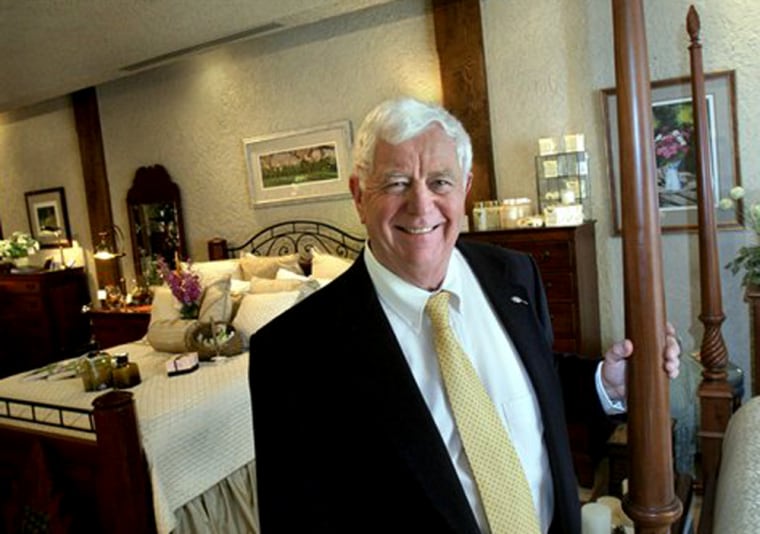Bob Stec works in a company town. A furniture town. A town so tightly tied to the business of making tables and chairs and sofas and beds that they share the same name.
But Bob Stec is an importer.
That’s the only way he believes Lexington Home Brands, the privately held company he heads, is able to survive. And despite the stigma attached to job offshoring and the negative publicity of Stec’s decision to close more than a dozen plants and lay off thousands of workers since 1999, his company is a success.
“When the Titanic goes down, you try to save as many people as you can,” Stec said. “We used to be a 100 percent domestic producer and we were a financial disaster. Now we are importing and I’d put our financial health up against anyone.”
Stec was at the center of a recent spat with North Carolina artist Bob Timberlake, a pioneer in celebrity-branded furniture who has long insisted his signature collection of traditional furniture be made in America. But while keeping a “Made in the USA” tag on his furniture is important to Timberlake and a few others, it’s all but impossible today to furnish a home without buying something made overseas.
And consumers, according to analysts, retailers and industry executives, don’t much care.
“All they care about is the price and quality,” said Lin Brown, the manager of a Furniture Express store in Sterling Heights, Mich. “It’s not an issue at all.”
A decade ago, imports made up less than a third of all-wood furniture sales in the U.S. They are now at about 55 percent, and industry analyst Jerry Epperson predicts they will rise again this year to nearly two-thirds of all-wood furniture sales. Last year, about 75 percent of all furniture sold in the U.S. was produced overseas.
It’s in the context of that evolving marketplace that Stec has tried to persuade Timberlake to allow Lexington to produce his signature furniture collection overseas.
Timberlake, who lives in Lexington, has long identified with the workers who once filled the city’s furniture plants and criticized companies that have moved production overseas. Since 2000, the industry has shed more than 20,000 jobs — over 27 percent of total employment — in North Carolina alone, according to the U.S. Bureau of Labor Statistics.
While Timberlake has allowed some of the newer, lower-priced furniture that bears his name to be made overseas, he has insisted his original line be made exclusively in America.
Lexington sold about $70 million worth of Timberlake-brand furniture in 2002, the most recent year for which sales figures were available. Sun Capital Partners Inc., which bought the company in 2002, does not disclose sales results. But the company shut down production in December, and when it resumes, Stec said it’s unlikely to be in Lexington.
Even companies that are proud of their continued commitment to domestic production are not 100 percent “Made in the USA.” Vaughan-Bassett Furniture Co. makes 96 percent of its furniture and other products at plants in North Carolina and Virginia, but there is that fraction that comes from plants overseas.
“We actually reduced the amount we imported in 2005,” said Doug Bassett, senior vice president of sales for the Galax, Va.-based company. “Maybe we’re the last man standing.”
To compete with importers, Vaughan-Bassett has worked to develop a reputation as one of the lowest-cost producers of wood bedroom furniture in the U.S., while also focusing on speed of production and delivery. Instead of taking weeks and months, Vaughan-Bassett can deliver orders of some of its products to most retailers in the eastern half of the country within 10 days.
Vaughan-Bassett also has reinvested some of its profits back into its plants and employees. Between 1997 and 2001, the company spent about $40 million on new equipment and technology, he said.
“Many of the companies that have become importers sealed their own fate by failing to invest in their own factories and people,” Bassett said. “They cry crocodile tears that they are being defeated by China, when in fact it was their management that failed to invest in them.”
But while Bassett said the company was more profitable in 2005 than 2004, he admits the company’s annual sales have fallen about 20 percent from their 2000 peak of $160 million.
“We have suffered from plant closures and lost sales,” Bassett said. “And we had to take steps to deal with it.”
Ken Smith, a furniture analyst with BDO Seidman in High Point, said he doesn’t know how long Vaughan-Bassett will be able to succeed as a primarily domestic manufacturer. He said “Made in the USA” tags don’t have a lot of marketing power, since the vast majority of consumers are mostly interested in price.
“A lot of people talk about it,” he said. “But they vote with their pocketbook.”
At Sam Harper’s store in Henderson, there’s not even a lot of talk. The co-owner of Vance Furniture Co., who has been selling furniture for 44 years, said it’s a rare event when one of his customers inquires about the origin of a piece of furniture.
“Once in a while we will get someone who comes in asking for something that is made in the USA,” he said. “I’d say 90 percent of people don’t know or care where something came from. And very few ask.”
Ask Stec, and he’ll tell you it’s just an extension of a well-established trend.
“If you look at Wal-Mart, it says it all,” he said. “They used to boast that everything they sold was made in America. Then it was mostly everything was made in America. Now it’s just the lowest prices — always.”
